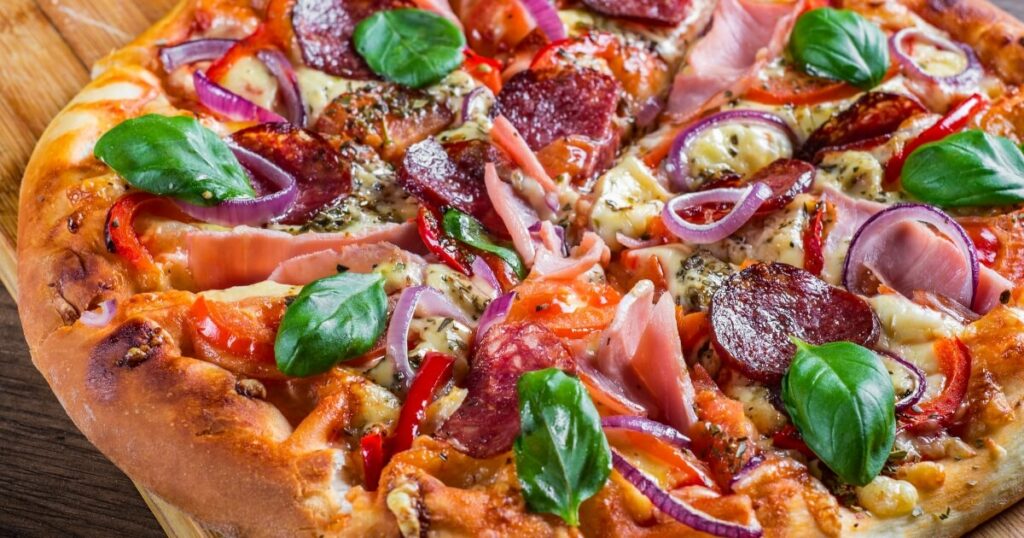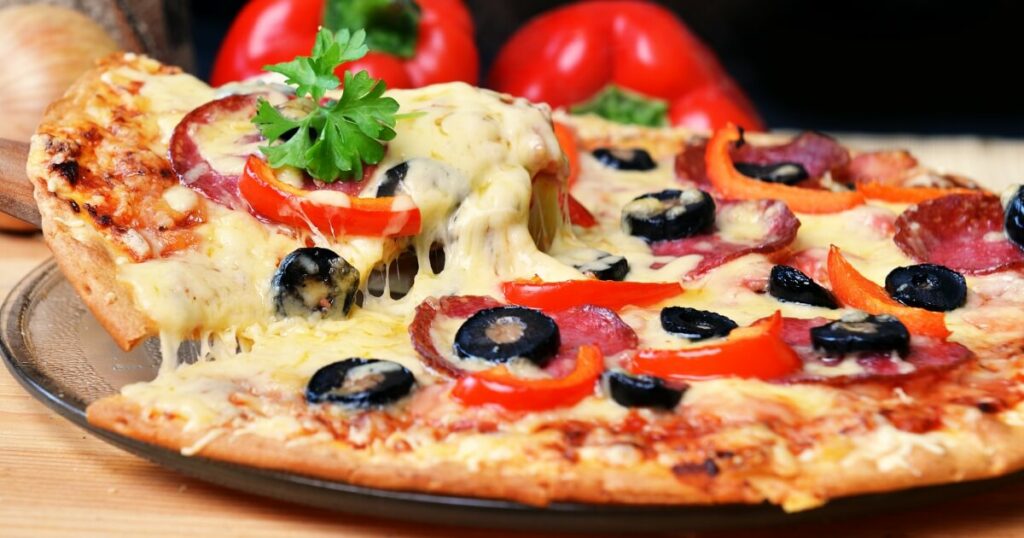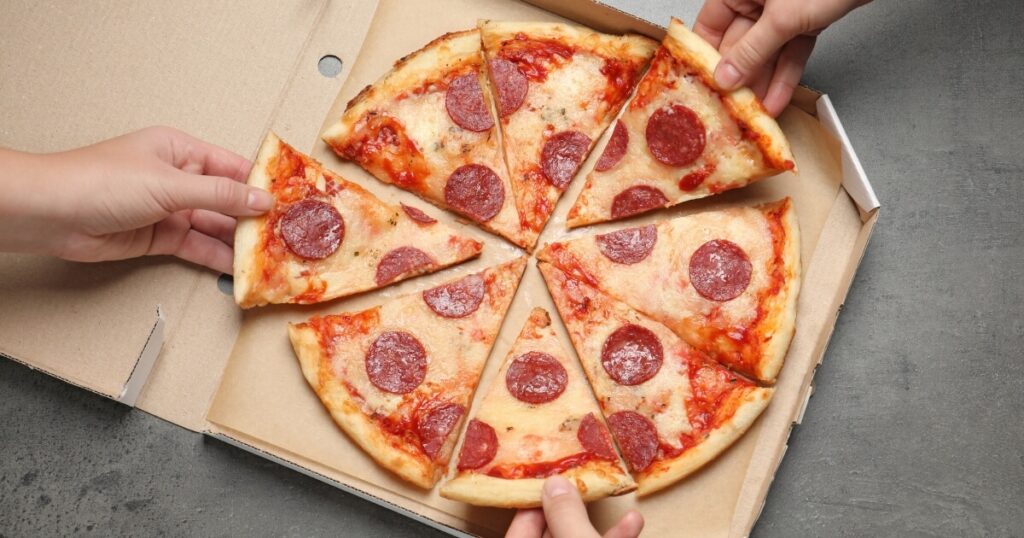Pizza, the very word can make your mouth water. It’s a symphony of flavors that has captivated taste buds around the globe. But, what does pizza taste like?
Imagine biting into a slice of pizza. The crust is warm and slightly chewy, offering a comforting base. The tomato sauce is slightly acidic, cutting through the richness of the cheese. The cheese itself is sharp and savory, melting perfectly on your tongue. And then there are the toppings, each adding their unique flavor profiles, making every bite a new experience.
In this guide, we’ll look at the umami-rich cheese, the sweet and tangy tomato sauce, and even the toppings that add an extra layer of complexity. So, whether you’re looking to perfect your pizza recipe or just a curious foodie, stick around as we embark on this flavorful journey.
How Does Pizza Taste?

When it comes to the taste, texture, and aroma of pizza, there’s a lot to unpack. Here’s a detailed breakdown:
Taste
- Sweetness: This comes from the dough and the caramelization of the toppings, especially if you’re using vegetables like onions. The tomato sauce also has a natural sweetness to it.
- Sourness: The tomato sauce brings a tangy element to the pizza. This acidity helps balance out the richness of the other ingredients.
- Saltiness: Cheese, along with any cured meats like pepperoni or ham, contribute to the salty flavor. A sprinkle of salt is also often added to the dough.
- Bitterness: This is a subtle taste, usually coming from any charred parts of the crust or from certain toppings like olives or arugula.
- Umami: Often described as savory or meaty, umami is a significant part of the pizza’s taste. Cheese, particularly parmesan and cured meats, are rich in umami. Even the tomatoes contribute to this.
Texture
- Crust: The crust should be slightly chewy on the inside and crispy on the outside. The bottom of the pizza can also have a slight crunch from the oven.
- Cheese: When melted, the cheese becomes gooey and stringy, adding a layer of richness to the pizza.
- Toppings: The texture of the toppings can vary widely, from the softness of sautéed mushrooms to the crunch of bell peppers.
Aroma
The aroma of a pizza is an irresistible mix of the yeasty dough, the sweet and tangy tomato sauce, the rich and savory cheese, and the various toppings.
The smell is cheesy, tomato-y, and slightly doughy. It’s an aroma that’s hard to resist, drawing you in and making you want to take a bite.
Each of these elements plays a crucial role in creating the overall taste experience of a pizza. They come together to form a complex and satisfying dish, making pizza a beloved food worldwide.
Why Is Pizza So Good?
Pizza’s undeniably irresistible, and it’s not just because of its taste. A multitude of factors contributes to why pizza is the best any day of the week:
Balance of Flavors: Pizza strikes a perfect balance between sweet, sour, salty, bitter, and umami flavors.
The sweetness of the dough and caramelized toppings, the tanginess of the tomato sauce, the saltiness of the cheese and cured meats, the subtle bitterness from charred parts or certain toppings, and the savory umami from cheese and meats all come together to create a harmonious taste experience.
One of the great things about pizza is its versatility. You can top it with almost anything, allowing for a wide range of flavor combinations. This means there’s a pizza out there for almost every palate.

The combination of a crispy crust, gooey cheese, and various toppings provides a satisfying contrast of textures.
However, not all pizzas are created equal, and there are some common complaints and misconceptions about the taste of pizza:
Too Greasy: Some pizzas, especially those with a lot of cheese or fatty meats, can be overly greasy. This can make the pizza feel heavy and can overpower the other flavors.
Soggy Crust: The crust can become soggy rather than crispy if a pizza isn’t cooked properly. This is often a problem with heavily topped pizzas, as the moisture from the toppings can seep into the crust.
Overpowering Toppings: While variety in toppings is generally a good thing, using toppings with very strong flavors can sometimes overshadow the more subtle flavors of the dough, cheese, and sauce.
As for the question of fresh vs. frozen pizza, most would agree that fresh pizza is superior. Fresh pizza has a better texture and flavor, especially when it comes to the crust. However, frozen pizza has come a long way and can be a convenient and tasty option when you’re short on time.
In the end, whether a pizza tastes good or not can be quite subjective and depends on personal preferences. But when it’s done right, pizza can be a truly delicious and comforting experience.
How to Make Pizza Taste Better: Popular Toppings
Enhancing the taste of your pizza can be as simple as choosing the right toppings or pairing it with a delicious dipping sauce. Here are some popular choices and tips to elevate your pizza experience:
Toppings
- Cheese: While mozzarella is the classic choice, other types of cheese can still make a great pizza. Try adding some cheddar for a sharper flavor, gorgonzola for a touch of creaminess, or parmesan for an umami boost.
- Meats: Pepperoni, sausage, and ham are all popular meat toppings, but consider trying something different like prosciutto, bacon, or even grilled chicken. Remember, fatty meats can render out during cooking, adding flavor to the entire pizza.
- Vegetables: Bell peppers, onions, mushrooms, and olives are all standard, but consider more unique options like artichokes, arugula, or even sweet corn. Remember to slice them thinly or pre-cook tougher vegetables to ensure they cook evenly with the rest of the pizza.
- Herbs and Spices: Fresh basil, oregano, and crushed red pepper can add a burst of flavor to your pizza. Consider adding some fresh herbs after the pizza is cooked to preserve its delicate flavor.
Dipping Sauces
- Garlic Butter: Melt some butter and add minced garlic for a simple and delicious dip. You can also add some parsley for freshness.
- Marinara Sauce: A side of extra tomato sauce can be great, especially if you love a saucy pizza. Add as much spice as yuou like with some chili flakes if you like heat.
- Ranch Dressing: A favorite in the US, ranch’s creamy and tangy flavor pairs well with many pizza toppings.
- BBQ Sauce: If you’re a fan of BBQ chicken pizza, you’ll probably enjoy dipping your pizza in some tangy BBQ sauce.
What Does Pizza Look Like?
In its most traditional form, a pizza is a beautiful sight to behold.

Here’s a detailed description of what a typical pizza looks like:
Shape: Most commonly, a pizza is round. It’s crafted from a ball of dough that’s been stretched and tossed until it forms a thin, even circle. However, you’ll also find square or rectangular pizzas, particularly for styles like Sicilian or Detroit-style pizza.
Crust: The crust is the border of the pizza, typically golden brown, sometimes speckled with darker spots from the oven’s intense heat. It’s thicker than the base, providing a sturdy edge to hold onto. The surface of the crust may glisten slightly if it’s been brushed with olive oil.
Base: The base of the pizza, the part covered with toppings, is typically thinner. It should be evenly covered with a layer of tomato sauce, leaving just a small border for the crust.
Sauce: The sauce is usually a vibrant red, though the exact shade can vary depending on the tomatoes used. It’s spread evenly over the dough, but it shouldn’t be so much that it’s pooling.
Cheese: On top of the sauce, you’ll find a layer of cheese. When perfectly cooked, the cheese melts into a creamy white blanket that covers the pizza, with golden brown spots where it’s started to bubble and caramelize.
Toppings: The toppings are scattered over the cheese. Depending on your chosen choice, you might see slices of pepperoni, mushrooms, bell peppers, chunks of sausage or pineapple, or leaves of spinach or basil. They should look vibrant and appetizing, cooked just enough to bring out their best flavors.
Aroma: While not part of the visual, the aroma of a fresh pizza is a crucial part of its appeal. The scent of the baking dough, melting cheese, and sizzling toppings are mouthwatering, adding to the overall anticipation of that first bite.
A pizza is a feast for the eyes as much as it is for your taste buds. Its visual appeal is another big part of what makes pizza so loved.
Is Pizza Healthy?
On the one hand, pizza is often classified as comfort food, associated with indulgence, and often high in calories, sodium, and fat, especially when loaded with high-fat meats and extra cheese.
This has led to a common perception that pizza falls more into the “junk food” category. However, this doesn’t tell the whole story.
Pizza, at its core, is simply bread, tomatoes, and cheese, all of which can be part of a balanced diet. The dough provides carbohydrates for energy, the tomato sauce is rich in vitamins and antioxidants, and the cheese offers protein and calcium.
Furthermore, by choosing your toppings wisely, you can significantly increase the nutritional value of your pizza. Adding a variety of vegetables can provide additional vitamins, minerals, and fiber. Choosing lean proteins like grilled chicken or turkey can reduce the fat content while still providing the protein your body needs.
Portion control is another important factor to consider. While eating an entire pizza by yourself might lead to overconsumption of calories and sodium, enjoying one or two slices can be part of a balanced diet.
It’s also worth noting that not all pizzas are created equal. A pizza from a fast-food chain, which may use more processed ingredients and additives, will likely be less healthy than a pizza made at home with fresh, whole ingredients.
While pizza can be high in calories, sodium, and fat, it can also be made healthier by choosing whole ingredients, loading up on vegetable toppings, opting for lean proteins, and practicing portion control.
So, while it might not classify as a healthy food, pizza can be part of a balanced diet.
My Tasty Thoughts
What makes pizza truly special is its versatility. It doesn’t matter if you prefer a classic Margherita, love a meat-loaded feast, or prefer a veggie-packed slice, there’s a pizza for you. And with the right choices, you can make your pizza not just delicious but also a part of a balanced diet.
Remember, the best pizza is one that caters to your taste. Don’t be afraid to try different groupings of toppings and sauces to find your perfect pizza.
So, if you’ve ever wondered why pizza tastes so good, now you know. It’s a combination of quality ingredients, careful preparation, and the magic that happens when it all comes together in the oven.
Whether you’re making it at home or enjoying it at your favorite pizzeria, pizza is more than just a meal – it’s an experience. And it’s one that I wholeheartedly recommend.